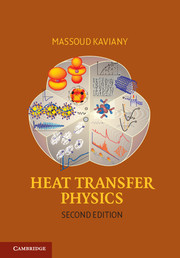Book contents
- Frontmatter
- Dedication
- Contents
- Preface
- Acknowledgments
- 1 Introduction and Preliminaries
- 2 Molecular Orbitals/Potentials/Dynamics and Quantum Energy States
- 3 Carrier Energy Transport and Transformation Theories
- 4 Phonon Energy Storage, Transport, and Transformation Kinetics
- 5 Electron Energy Storage, Transport, and Transformation Kinetics
- 6 Fluid Particle Energy Storage, Transport, and Transformation Kinetics
- 7 Photon Energy Storage, Transport, and Transformation Kinetics
- APPENDIX A Tables of Properties and Universal Constants
- APPENDIX B Derivation of Green–Kubo Relation
- APPENDIX C Derivation of Minimum Phonon Conductivity Relations
- APPENDIX D Derivation of Phonon Boundary Resistance
- APPENDIX E Derivation of Fermi Golden Rule
- APPENDIX F Derivation of Equilibrium, Particle Probability Distribution Functions
- APPENDIX G Phonon Contributions to the Seebeck Coefficient
- APPENDIX H Monte Carlo Method for Carrier Transport
- APPENDIX I Ladder Operators
- Nomenclature
- Abbreviations
- Glossary
- References
- Index
6 - Fluid Particle Energy Storage, Transport, and Transformation Kinetics
Published online by Cambridge University Press: 05 June 2014
- Frontmatter
- Dedication
- Contents
- Preface
- Acknowledgments
- 1 Introduction and Preliminaries
- 2 Molecular Orbitals/Potentials/Dynamics and Quantum Energy States
- 3 Carrier Energy Transport and Transformation Theories
- 4 Phonon Energy Storage, Transport, and Transformation Kinetics
- 5 Electron Energy Storage, Transport, and Transformation Kinetics
- 6 Fluid Particle Energy Storage, Transport, and Transformation Kinetics
- 7 Photon Energy Storage, Transport, and Transformation Kinetics
- APPENDIX A Tables of Properties and Universal Constants
- APPENDIX B Derivation of Green–Kubo Relation
- APPENDIX C Derivation of Minimum Phonon Conductivity Relations
- APPENDIX D Derivation of Phonon Boundary Resistance
- APPENDIX E Derivation of Fermi Golden Rule
- APPENDIX F Derivation of Equilibrium, Particle Probability Distribution Functions
- APPENDIX G Phonon Contributions to the Seebeck Coefficient
- APPENDIX H Monte Carlo Method for Carrier Transport
- APPENDIX I Ladder Operators
- Nomenclature
- Abbreviations
- Glossary
- References
- Index
Summary
Fluid particle refers to matter in a gas or liquid phase, with the particle being the smallest unit (made of atoms or molecules) in it, for which further breakdown would change the chemical identity of the particle. For a fluid in motion, the convection heat flux vector qu = ρfcp, fufT and the surface-convection heat flux vector qku (which describes the interfacial heat transfer between two phases in relative motion, in which at least one phase is a fluid) are influenced by the specific heat capacity cp, f of the fluid particle (whereas qku also depends on the isotropic fluid thermal conductivity kf, viscosity üf, and velocity). The fluid (gas or liquid) velocity uf can be subsonic or supersonic, and for contained gases at low pressures or in small spaces, it is possible for fluid particle–surface collisions to dominate over the interparticle collisions. In this chapter, we examine energy storage and transport in fluids, as well as fluid interactions with surfaces (and the associated fluid flow regimes). We will discuss how the effective conductivity of the fluid ⟨kf⟨ can be influenced by suspended particle, turbulence, and free electrons.
Fluid particles can be monatomic, diatomic, or polyatomic, mononuclear or polynuclear, with various molecular symmetries and asymmetries, and can have five types (forms) of energy: potential (among the constituent atoms and molecules), electronic, translational, vibrational, and rotational (Figure 1.1). The electronic energy is part of potential energy, however, here we use the potential energy for inter fluid particle interactions only.
- Type
- Chapter
- Information
- Heat Transfer Physics , pp. 434 - 518Publisher: Cambridge University PressPrint publication year: 2014



